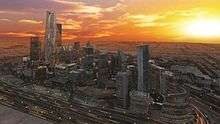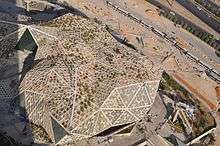King Abdullah Financial District
The King Abdullah Financial District (KAFD) is a new development under construction near King Fahad Road in the Al Aqeeq area of Riyadh, Saudi Arabia[1][2] being undertaken by the Rayadah Investment Corporation[3] on behalf of the Pension Authority of the Kingdom of Saudi Arabia.


Structure
The project consists of 59 towers in an area of 1.6 million square meters. It will provide more than 3 million square meters of space for various uses, 62,000 parking spaces and accommodation for 12,000 residents. In 2011, it was the largest project in the world seeking green building accreditation.[4] Bombardier won a $241m contract to build an automated monorail for the development.[5][6][7] The design guidelines do not separate the genders in the district.[7] The KAFD master plan was designed and overseen by Danish architectural firm Henning Larsen Architects. International architecture firms such as HOK, Omrania, SOM, CallisonRTKL, Gensler, and Foster + Partners were commissioned to design individual buildings in the district, such as the 380-meter PIF Tower (HOK and Omrania).[8] Additional design work was provided by W Architecture and Landscape Architecture. The CEO of the development is Waleed Aleisa.[9] The project was at one point estimated to cost 29 billion Saudi riyals ($7.8 billion).[10]
Upon completion, KAFD is expected to host round 50,000 residents[11]. As Riyadh is characterized by its high temperature, a solar system will be installed to cool the passenger bridges that are going to act as a network that connects 30 building together[12].

The project is considered to be long over due and needed for a city of the size and position of Riyadh. The key issue with the project was timing as it was announced and incepted during the 2008 financial crisis[14]. A number of local and international commentators highlighted the potential oversupply issue with the project.[15] However, others, such as Hans Mueller in Saudi Real Estate Companion, believe that the market will be able to absorb the supply in the medium term.
The first phase was expected to open by July 2017.[16]
According to an interview with the Crown Prince Mohammed Bin Salman, King Abdullah Financial District will host the G20 summit in 2020.
See also
- List of things named after Saudi Kings
References
- Saudis Plan Middle East Financial Center, New York Times, May 10, 2006.
- Saudi Mobile Operators End Free Global Roaming, Asharq Al-Awsat, April 27, 2013
- Riyadh King Abdullah Financial District: Phase 2: Towers, MEED, January 6, 2013.
- King Abdullah Financial District now the world's biggest green development, MEED, October 16, 2011.
- Bombardier wins Saudi deal, Toronto Star, May 31, 2010.
- Bombardier wins $241m Saudi monorail contract, Saudi Gazette, July 1, 2010.
- Saudi Urban Projects Are a Window to Modernity, New York Times, December 12, 2010.
- "Saudi Arabia is building a future for its millennial population - Archpaper.com". archpaper.com. Retrieved 2018-11-19.
- "Saudi Arabia's financial hub". The Economist. 30 January 2016. Retrieved 31 January 2016.
- "Hill International Receives Contract Extension on the $7.8 Billion King Abdullah Financial District in Riyadh".
- Garfield, Leanna. "Saudi Arabia is building a $10 billion city on the sand — here's what it will look like". Business Insider. Retrieved 2019-02-10.
- Garfield, Leanna. "Saudi Arabia is building a $10 billion city on the sand — here's what it will look like". Business Insider. Retrieved 2019-02-10.
- "Omrania-designed KAFD Grand mosque is shortlisted for WAF Award". Commercial Interior Design. Retrieved 2018-11-19.
- "JLL Riyadh Real Estate market Overview Q1 2013" (PDF). JLL.
- ArgaamPlus. "Saudi office space glut dampens demand in H1: Knight Frank". ArgaamPlus. Retrieved 2017-05-31.
- "Riyadh's new financial hub struggles with ownership uncertainty". Reuters. 2017-04-25. Retrieved 2017-08-06.